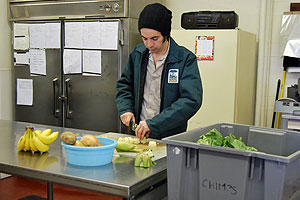Few images will stay as indelibly with me as the sight of a 500 pound grizzly bear devouring a horse bone while standing waist high in water. I should add to that the sight of a geriatric koala slurping his eucalyptus meal. In the aquatic realm, there's something ineffably captivating about watching an anemone's candy-pink arms wrap around its lunch of grain-sized krill.
Witnessing the feeding scenes firsthand, I marveled at the bewilderingly diverse array of mammals, reptiles, amphibians, birds and insects that are fed every day at zoos and aquariums worldwide. Fortunately, to facilitate the feedings and developments of diets, today there are tools like Zootrition, a software program developed by the St. Louis Zoo that allows for the nutritional evaluation and comparison of various diets.

Then there's ZuPreem, a manufacturer of ready-made meals for exotic animals. A perusal of their web site reveals such tasty items as "Primate O's" (naturally preserved with vitamins C and E), canned monitor food (boasting nutrient levels comparable to "a mouse in a can"), bags of dry omnivore diet for the hungry bear or boar.
The upshot of this is that animals at facilities accredited by the Association of Zoos and Aquariums generally receive diets that are rich and varied, frequently monitored for the effect they have on the animals to whom they’re served. Not surprisingly, many animals at zoos and aquariums live longer in captivity than they would in the wild, not only because of the high level of care they get in captivity but also because they are safe from predation in the wild.
Jacquelyn Jencek, Chief of Veterinary Services at the San Francisco Zoo, shared with me an amazing story of how they greatly expanded the longevity of koalas with an intervention that has been emulated at other zoos throughout the nation. Most koalas in the wild don’t live past thirteen years of age, when their teeth have been ground down from years of eating coarse eucalyptus leaves and they no longer have enough dental surface to break down the leaves and extract their nutrients. Thus, even if they attempt to eat the leaves, they can still die of malnutrition. So the SF Zoo decided to help the koalas by breaking down dried eucalyptus leaves with a coffee grinder and mixing the powder with water and supplements, turning it into a solution that could be fed by vial to geriatric koalas at the zoo. The zoo first tried administering the eucalyptus solution to Clarry, who lived to be nearly 20 years old, and is now giving it to Clarry's son, Leo, and a few other koalas whose longevity attests to its success. According to Dr. Jencek, "they love the taste of it", and it's clearly good for them.